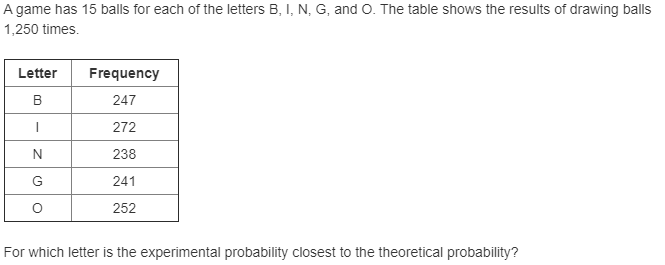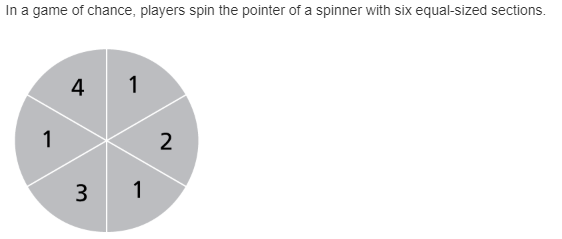Maria spinning a spinner. The spinner has 5 equal sections labeled A-E. What is the probability the spinner will land on the letter "A"?
P(A) = 1/5 = 20%
You flip a coin and spin a spinner with 5 different colored, equal sections. What is the probability of landing on heads and red?
P(heads and red) = 1/10 = 10%
You are trying to decide what to wear to school. You know you have a green pair of pants, a red pair, and a blue pair. You also have a brown shirt, a plaid shirt, and a yellow shirt. How many different outfit combinations can you make?
9 combinations
A probability model includes P(1) = 7/10 and P(2) = 1/4. What probability for P(3) would complete the model?
P(3) = 1/20
How likely is it that I pull a card from a deck of cards and it is red?
*Impossible*Unlikely*Equally likely*Likely*Certain*
Equally Likely
The yearbook club is handing out T-shirts to its members. There are 5 blue, 7 green, 9 red, and 4 yellow T-shirts in all. If Jacob is handed a T-shirt, what is the probability that the color is red?
P(red) = 9/25 = 36%
You're at a clothing store that dyes your clothes while you wait. You get to pick from 444 pieces of clothing (shirt, pants, socks, or hat) and 333 colors (purple, blue, or orange).
If you randomly pick the piece of clothing and the color, what is the probability that you'll end up with an blue socks?
P(blue and socks) = 1/12 = 8.3%
A basketball player makes 70% of his free throws. The random numbers below represent 20 trials for a simulation. Let the numbers 0 to 6 represent a made free throw and let 7 to 9 represent a missed free throw. Use this simulation to estimate the probability that the player makes both free throws.
(9,8) (3,2) (8,7) (0,5) (2,6) (8,4) (5,5) (5,1) (5,0) (4,2) (9,8) (0,3) (0,0) (8,1) (3,8) (1,1) (1,0) (9,4) (6,2) (1,8)
P(make both free throws) = 3/5 = 60%

What is O?
How likely is it that a number cube is tossed and lands on 1?
*Impossible*Unlikely*Equally likely*Likely*Certain*
Unlikely
You are playing a game with a regular die. You roll the die 30 times. How many times would you expect to roll a 3 or a 6?
10 times
If you flip three fair coins, what is the probability that you'll get a head on the first flip, a tail on the second flip, and another head on the third flip?
P(head, tail, and head) = 1/8 = 12.5%
An ice cream store sells special ice cream sandwiches. If there are 3 different kinds of cookies and 5 flavors of ice cream plus 2 different kinds of toppings, how many different ice cream sandwiches can be made?
30 types
Why is theoretical probability sometimes not the same as experimental? For example, if the chance of landing on Tails is 50% why when I flip a coin 10 times did I land on Tails 6 times?
Experimental depends on the number of trials you conduct and 10 trials is a small number. Experimental probability will get closer to the theoretical probability the more trials you do.
How likely is it that a 6 sided die is rolled and lands on 9?
*Impossible*Unlikely*Equally likely*Likely*Certain*
Impossible
You spin a spinner with 4 different color sections 500 times. How many times should each color come up?
125 times
In a bag there are 10 blue marbles, 4 red marbles, 8 yellow marbles, and 2 orange marbles. What is the probability of selecting a red marble and yellow marble?
P(red and yellow) = 1/2 = 50%
The random numbers below represent 10 trials of a simulation.
2632, 1365, 9367, 2056, 0026,
6564, 1434, 8045, 4781, 8681
The numbers 0–7 represent students who watched television last night, and the numbers 8 and 9 represent students who did not. Based on the simulated data, what is the probability that exactly 2 out of a group of 4 randomly selected seventh-graders watched television last night?
P(exactly 2 students) = 1/10 = 10%
 What are the probabilities of each outcome in the sample space?
What are the probabilities of each outcome in the sample space?
P(1) = 1/2 = 50%
P(2) = 1/6 = 16.7%
P(3) = 1/6 = 16.7%
P(4) = 1/6 = 16.7%
How likely is it a coin lands on either heads or tails?
*Impossible*Unlikely*Equally likely*Likely*Certain*
Certain
On a farm there are 4 goats, 10 horses, 6 sheep, 5 pigs, and 15 cows. The farmer will select one animal at random. What is the probability that the farmer will select a goat or a sheep?
P(goat or sheep) = 1/4 = 25%
If you flip three fair coins, what is the probability that you'll get two tails and one head in any order?
P(T, T, and H) = 3/8 = 37.5%
Mr. Kilgore is making next year's schedule for your class. The choices for each period of the day are listed below. Create a tree diagram to help Mr. Kilgore see all of his options. 1st period: Math or Science 2nd period: English, Social Studies, or Gym 3rd period: Art, Music, or Spanish. How many possible outcomes are there?
18 combinations
A spinner has six equal-sized sections numbered 1, 1, 2, 2, 3, and 4. What is the sample space for the spinner?
{1, 1, 2, 2, 3, 4}
How likely is it that a number cube lands on 2 and a coin lands on heads?
*Impossible*Unlikely*Equally likely*Likely*Certain*
Unlikely